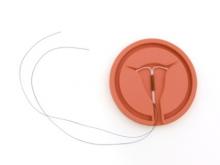Intrauterine devices appeared to protect against cervical cancer in a pooled analysis of data from 26 epidemiologic studies, published online Sept. 12 in the Lancet Oncology.
In a combined study population of 19,691 women around the world, there was a strong and consistent inverse association between IUD use and cervical cancer risk. Women who had used an IUD were at approximately half the risk of nonusers for cervical cancer in the first year of use, and that level of protection was maintained through 10 years of use, wrote Dr. Xavier Castellsagué of the Institut Català d’Oncologia, Bellvitge Biomedical Research Institute, L’Hospitalet de Llobregat, Catalonia, Spain, and his associates.
IUDs did not protect against human papillomavirus infection. Rather, they appeared to reduce the likelihood that HPV would progress to cervical cancer, the researchers noted.
IUDs are known to protect against endometrial cancer, but studies of a possible effect on cervical cancer or cervical HPV infection have yielded inconsistent results. "To our knowledge, this is the first large epidemiological study . . . to explore such potential associations taking into account cervical HPV status and Pap screening history," they said.
Dr. Castellsagué and his colleagues examined data from 16 HPV prevalence surveys and 10 case-control studies performed during the past 20 years.
The population-based prevalence surveys were conducted by the International Agency for Research on Cancer and included 13,179 HPV-negative women and 2,093 HPV-positive women in Vietnam, Thailand, South Korea, China, Mexico, Argentina, Colombia, Chile, Nigeria, Spain, and Poland. The case-control studies involved 2,205 women with cervical cancer and 2,214 matched control subjects without cervical cancer in Algeria, Brazil, Colombia, India, Mali, Morocco, Paraguay, Peru, the Philippines, Thailand, and Spain.
Robust inverse associations were consistently found between use of an IUD and all cervical cancers combined (odds ratio, 0.55). In addition, strong associations were consistently found between use of an IUD and two major histologic groups: squamous-cell carcinoma (OR, 0.56) and adenocarcinoma plus adenosquamous carcinomas (OR, 0.46).
"To address further the potential effect of residual confounding, we did a stratified analysis to assess the association between IUD use and cervical cancer risk within subcategories of selected covariates known to be potential confounders or cofactors in cervical carcinogenesis. These stratified analyses showed a consistent inverse association between cervical cancer and IUD use within each category of age, education, marital status, number of screening Paps, number of sexual partners, [and] parity," the investigators said (Lancet Oncol. 2011 Sept. 13 [doi:10.1016/S1470-2045(11)70223-6]).
In contrast, there was no association in any of these analyses between IUD use and HPV infection, as assessed by tests for HPV DNA in cervical scrapings. "Overall, the associations found in our study strongly suggest that IUD use does not modify the likelihood of prevalent HPV infection, but might affect the likelihood of HPV progression to cervical cancer," they wrote.
The researchers proposed that IUDs may exert their anticarcinogenic effect "through the introduction of a reactive, chronic, low-grade, sterile inflammatory response in the endometrium, endocervical canal, and cervix that could modify, via changes in the local mucosal immune status, the course of HPV infections. Microscopic observation of typical cellular changes in the cervices of IUD users support this theory," noted Dr. Castellsagué and his associates.
It is also possible that trauma to the cervical tissue from the insertion of the device "induces local small foci of chronic inflammation and a long-lasting immune response similar to that noted in patients after colposcopically guided punch biopsies. This alternative hypothesis would explain better the immediate protective effect found for short-term users, and the observation that there was no difference in the protective effect by years of IUD use," they said.
A third possibility would be that insertion of the IUD scrapes away preinvasive lesions on the cervix, which also would explain why duration of IUD use doesn’t influence the protective effect.
"These possible mechanisms are speculative and provocative, but emphasize our limited knowledge and the need for other study designs to explore the underlying mechanisms by which IUDs might exert a protective effect on cervical cancer risk," they added.
Dr. Castellsagué and his colleagues concluded that, "in view of the wide use of IUDs worldwide, women, gynecologists, and reproductive-health professionals can be reassured that IUDs do not seem to increase the risk of cervical HPV infection; and our study contributes solid evidence that IUD use might even reduce the risk of developing cervical cancer."


